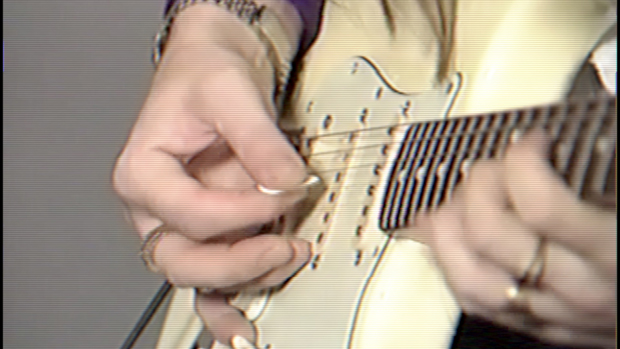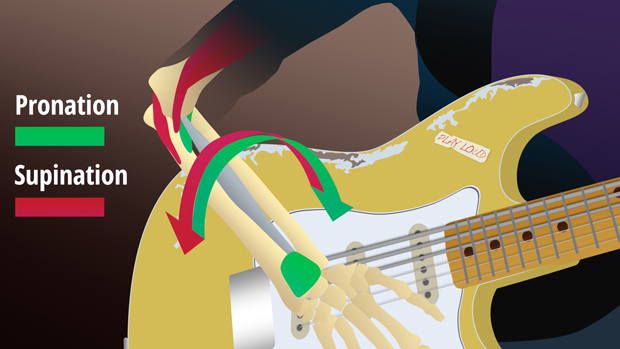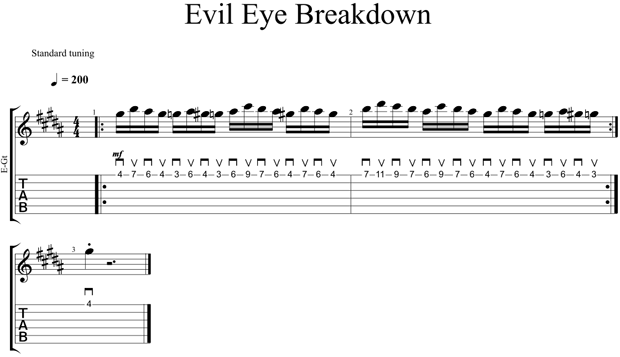Learn Yngwie Malmsteen's legendarily fast rotational picking mechanic
Malmsteen's rotational motion mechanic is a highly capable all-rounder and also a great introduction to rotational picking techniques that are so common in guitar

The most fundamental challenge in fast picking is also the easiest to spot from halfway across the room: the motion mechanic.
To play notes with a pick, we need a way of moving it back and forth in the classic alternating down-up picking sequence.
Historically, this movement, or motion mechanic, has been the most visible and most commonly discussed component of picking technique. The sheer variety of motion mechanics used by elite players has been a source of fascination and bewilderment.
While rotational forearm techniques are probably the most common, elbow and even finger-based motion mechanics are also possible.
Yngwie Malmsteen, to take a highly relevant example for the Cracking the Code documentary series, uses all three. Malmsteen's legendarily fast rotational motion mechanic, which he employs for pure alternate picking, is a highly capable all-rounder and also a great introduction to rotational picking techniques that are so common in guitar.
Finding the Slant
If you haven't already settled on a motion mechanic for alternate picking, or if you'd like to experiment with a new one, Malmsteen's rotational mechanic is natural, it's easy to replicate and it's fast and effective. So it's an ideal companion to his entire system of one-way pickslanting, even numbered note groupings and sweeping.
Here's how to do it: From an anchor position, with the right side of the palm resting on the bridge, simply rotate the hand downward so that the pick assumes the classic downward slant. This hand position should feel completely natural, similar to what happens when you hook your thumb into your belt loop. There should be no tension anywhere in the hand or arm because no real effort is required to make this happen. You're simply resting the hand against the body of the guitar and allowing gravity to do its work. Here's what it looks like when Malmsteen does it:

This is the classic downward pickslanting hand position that is key not just to Malmsteen's style, but also the styles of Randy Rhoads, Steve Vai, Eric Johnson, and so many other guitar legends.
You'll know you're doing it correctly when pickstrokes are no longer parallel to the strings, but angled with respect to them. Downstrokes now bury themselves between the strings - or hit the guitar's body. Upstrokes pull away from the guitar's body, and break free of the strings. This classic 'escaped' upstroke is the key to switching strings in the downward pickslanting system, and the reason that nearly all of Yngwie's purely alternate picked phases are designed to switch strings exclusively after upstrokes.
Making it Rotate
A powerful effect of Malmsteen's default hand position is what it does to the picking movement itself. Because of the way the hand rolls away from the body on upstrokes, the path it now traces in doing so is curved. This movement, known as forearm supination, is actually a type of rotation: the appropriately named radius is actually rotating around the other forearm bone, the ulna, which remains static. You can feel this pretty clearly if you simply place a finger under your forearm as you turn an imaginary doorknob: that bone doesn't move. Cool!
For the most part, the muscles involved in doing this are forearm muscles. They're small, they're fast, and they don't tire easily. This is where the speed in this technique comes from. But you'll notice that you can still hit the strings pretty hard this way if you want to. And that's because part of the power in this technique comes from above: the biceps.

You may be familiar with the larger and more powerful biceps as a component of Arnold Schwarzenegger's legendary Mr. Olympia-winning profile. They're in the upper arm, but they actually attach directly to the radius in the forearm.
This means they can also function as forearm supinators. This provides serious power on the upstroke, which is actually the stronger of the two movements when the elbow is bent, as it is in guitar playing. It's an incredible system, and the way it works in conjunction with the design of the guitar is, again, a fascinating coincidence of instrument design, anatomy and physics.
When these supination and pronation movements are small, it may not be completely obvious to you that the system is rotational. And that's fine. In fact, the best way to execute the movement is not to think about rotation at all. The rotation is simply the natural consequence of the hand position needed for downward pickslanting.
Magic Fingers
Astute observers will also note that Malmsteen also mixes a small amount of finger movement into the rotational mechanic. This is a fascinating bit of his intuitive genius for economic movement, and a hallmark of his sweeping technique in particular. But when it comes to pure alternate picking, this finger movement is subtle, and not the aggressive thumb bending that is sometimes attributed to him. A quick comparison of a consecutive upstroke and a downstroke, moments apart, makes this clear:

This graceful flexing of the thumb complements the prono-supination of the forearm by reducing the amount of movement necessary. But its effect is subtle, and not really the aggressive circular movement that is sometimes described. In fact, probably the simplest way to begin investigating Malmsteen's fascinating alternate picking mechanic is by focusing on its foundation in rotation first.
Evil Eye
And in that regard, once you assume the correct hand position, everything else should fall into place. In this example, a classic single-string Malmsteen gem from the song Evil Eye, it's not immediately apparent from the wide-angle clip what's happening. But as soon as we switch to the close-up camera, the rotational mechanic becomes apparent. Notice how the palm rolls away from the guitar on the upstroke and closes up against it on downstrokes. This is the rotational mechanic in action:

The Viking-Gypsy Connection
Now, if the motion mechanic you already have is working for you, I'm not suggesting you run out and change it. The real value in deconstructing Yngwie's system is understanding that specific motion mechanics like this are learnable by almost anyone. For too long, guitarists have been told they need to play the way 'that's right for you.'
This seemingly innocuous piece of advice has sent generations of players on a needless quest for technical unicorns. In reality, there is nothing special about human physiology that requires everyone to play differently. And there is nothing unusual about Malmsteen's motion mechanic that would prevent most people from learning it, regardless of their prior playing habits.
In fact, we only have to look at the gypsy jazz style and culture for evidence that specific motion mechanics can be taught with success to a wide range of players. The gypsy technique is one of the few standardized systems for motion mechanics and string switching mechanics that exist in guitar. Their motion mechanics are also based on supination/pronation, but with a distinctly arched forearm anchor on the guitar's body, rather than the bridge. This acoustic arch is common among players in many acoustic styles, even outside of gypsy jazz:
Critically, in the gypsy style, these mechanics are introduced at the earliest stages of instruction, so that gypsy players benefit from a common foundation in proven, efficient picking motion. This standardized approach has resulted in generations of players with extremely similar, and uniformly impressive abilities.
And this makes sense. When you remove the uncertainty from the equation, and allow dedicated players to focus their energies on proven systems with expected results, amazing skills can develop. And most of all, amazing music can be played.
Get The Pick Newsletter
All the latest guitar news, interviews, lessons, reviews, deals and more, direct to your inbox!
Troy Grady is the creator of Cracking the Code, a documentary series with a unique analytical approach to understanding guitar technique. Melding archival footage, in-depth interviews, painstakingly crafted animation and custom soundtrack, it’s a pop-science investigation of an age-old mystery: Why are some players seemingly super-powered?
“There are so many sounds to be discovered when you get away from using a pick”: Jared James Nichols shows you how to add “snap, crackle and pop” to your playing with banjo rolls and string snaps
Don't let chord inversions bamboozle you. It's simply the case of shuffling the notes around









![Joe Bonamassa [left] wears a deep blue suit and polka-dotted shirt and plays his green refin Strat; the late Irish blues legend Rory Gallagher [right] screams and inflicts some punishment on his heavily worn number one Stratocaster.](https://cdn.mos.cms.futurecdn.net/cw28h7UBcTVfTLs7p7eiLe.jpg)


